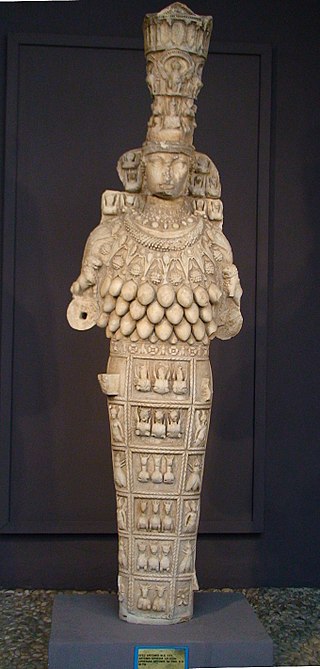Ephesians: A Primer

Recently, I began leading a Bible Study group through the and inductive study of Ephesians. Now…I say recently, but really we started back in January. And in my mind that was just a week or so ago. Anyone else?
I’ve been loving the study and the ladies that attend so much that I’d really like to write a short series on what I’m learning. Because, in my opinion, learning is better together. And writing things out has a way of cementing them in my mind. Ephesians is packed full of gems. I definitely want them cemented in my brain.
Before I get into the sweet pearls that I’ve been stringing up through our study, I think it’s important to get a little background. So today I’ve put together a primer on Ephesians. I’ve compiled my favorite background, cultural insight and reading tips right here for you. These are things that I have found helpful as I began to study Ephesians with the class.
Some of this can be gleaned from simply reading the book. Some of this takes stealth research skills you only acquire after years of indulging in Bible Geekery. Lucky for you, I really like nerding out over the Bible and I’ve already done a lot of Googling, concordancing, and cultural research.
Table of Contents
Here’s the order of what you’ll find below:
- Link to video overview
- Format
- Reading tips
- Author
- Readers and tension between Jews and Gentiles
- Timeline and Paul’s life timeline
- Ephesian culture, temple of Artemis, worship, economy
- Metaphors and themes
- Outline
- A free Ephesians study guide
Now, without further ado let’s get geeky about Ephesians.
Having cultural background will help us better understand the themes and ideas communicated by Paul in this letter. Believe it or not–when Ephesians was written, Paul did not have a 21st century American audience in mind. So there may be things we don’t quite understand without understanding a bit about the lives of the intended readers. For a quick overview, check out The Bible Project’s video on Ephesians. If you haven’t watched one of these you should. They are really well done.
The Format
Ephesians is a letter. This means it was written by a specific person, to a specific audience. In this case, it was written by Paul to the church in Ephesus. Because Ephesus was along highly traveled routes, it is thought that this letter circulated to other churches in the region as well.
Reading Tips
Since this is a letter, it was originally intended to be read aloud in one sitting. Its message builds upon itself and conveys several big overarching themes. Because of this, my biggest tip for reading and understanding Ephesians is to read it all the way through several times before diving in chapter by chapter.
Try using an inductive study method. Answering the questions who, what, when, where, why and how for each chapter (and recording my answers in a notebook) has helped me really understand and remember the information Paul is communicating.
The Author
Ephesians was written by Paul (formerly known as Saul.) Paul was a well-educated man of Jewish heritage. You are probably familiar with his radical transformation along the road to Damascus. There, his life took a drastic turn. He went from being the Church’s Enemy No. 1 to a man who committed to preaching the good news of Christ.
You can read about Paul’s conversion here.
The Readers
The original audience of this letter was believers living in Ephesus.
It’s important to note that the intended audience is believers. As Paul writes, he includes truths that apply to all mankind, but he also includes many things that are specific to a life changed and transformed by putting faith in Jesus.
Specifically these believers are mostly Gentiles. You can read more about Gentiles here. Basically, this just means anyone who wasn’t an Israelite by birth/ethnicity.
At the time of writing, there was an ongoing struggle for unity between Gentiles and Jews. Stereotypes, misunderstandings and suspicions were thrown around on both sides. Tension between Jews and Gentiles had been inbred over centuries. Things were reaching a boiling point as the early church was learning to become unified in Christ. Believers on both sides were having a hard time believing that God had made a way for these two groups to be fully unified. It was a mystery–and Paul nearly dries up his pen addressing this issue.
I found this article from Faith Church in Dyer, IN helpful in understanding the tension between Jew and Gentile.
The Timeline
People much smarter than me peg Ephesians to have been written around 60 AD. That means roughly 30 years after Jesus conquered death on the cross and the stoning of Stephen.
During his life, Paul went on three major missionary journeys. He visited Ephesus on his second journey then again on his third. You can read about his ministry there in Act 19.
Paul was imprisoned in Rome after his third missionary journey. It’s during this first imprisonment (house arrest) that he wrote Ephesians. One of my very favorite resources for studying the Epistles is this full timeline of Paul’s life from Blue Letter Bible. It is by far the best one I’ve found!
The Culture: Artemis

First of all, I don’t claim to be an expert. I’m just a girl who likes to learn. I find ancient Ephesus so interesting. However, I’m doing my best to give you relevant information…without going overboard.
The city of Ephesus was dominated by the huge Temple of Artemis. This temple was one of the Seven Wonders of the Ancient World. (And it’s why Ephesus is included in the board game Seven Wonders. If you haven’t played it, you should. It’s super fun.)
When I say the temple was huge, I mean enormous. Archeologists estimate it to be 50% longer and wider and 25% taller than the Parthenon in Greece. The cult dedicated to the goddess Artemis dominated Ephesian culture and was very widespread. Evidence of Artemis worship has been found in 30 ancient cities. Unlike other gods and goddesses that only represented one virtue–like war, beauty, fertility, etc–Artemis was a supreme goddess. She was a political protector, as well as a goddess that represented fertility/prosperity. “She” was a really big deal.
Artemis is a goddess in Roman and Greek mythology. There she is goddess of the hunt. Roman and Greek depictions of Artemis (or Diana) are super pretty. However, historians believe Artemis of the Ephesians to be a different looking goddess altogether. She looks only vaguely human and has orbs all over her body. (Two primary theories exist about this. One theory is that these orbs represent bull testicles, as bulls were used in ritual sacrifices to Artmis. The second theory is that they are breasts, a sign of fertility.) She is distant and hard to relate to. It’s important to understand that many readers would have formerly worshipped this alien looking idol. This is in stark contrast to the relational, warm, kind-intentioned God Paul described and praises in his letter.
The Culture: Economy
Ephesus was a major city, ideally positioned for trade. The economy thrived on trade, but also on the sale of idols. Now, until I really looked into it, I didn’t realize that the sale of idols was such a big portion of ancient economy. But it was.
Since the city was a mecca for Artemis worship, gold and silversmiths would sell small idols for individuals to take home to worship outside of the temple or between visits to the temple. Paul was preaching the message that there is only one True God. And that god is not Artemis. This message endangered the jobs of lots of tradesmen whose livelihoods depended on idol trade. In addition, the temple acted as a bank and owned many acres of farmland. If the temple became defunct, it meant a major blow to the Ephesian lifestyle as they knew it. Here are some commentaries on Acts 19:24 that explain more about idol trade.
The Culture: Library of Celsus

Another major landmark in Ephesus was the Library of Celsus. This was the third largest library in the ancient world. It’s relevant to our study of Ephesians because it demonstrates that this population valued knowledge.
Ephesus was a city under Roman rule. As with most Roman cities, the majority of citizens were not full Roman citizens. However, the audience would have fully understood the great value of being a citizen. Some perks of Roman citizenship include: being exempt from death penalty and torture, the right to own property, right to serve in public office, right to an appeal, right to vote. You can see a full list Roman rights here.
The Metaphors
While believers in Ephesus probably came from all walks of life, it can be assumed that many were lowly men and women from humble backgrounds. These would likely be tradesmen: carpenters, masons, fishermen, craftsmen, etc.
For this reason, Paul’s two major metaphors are buildings and bodies.
Those reading would probably have had a solid understanding of construction terms. They could look around a physically see a giant temple in front of them. Many probably worked on construction projects every day. Paul refers to Christ as the cornerstone. He also refers to believers as a temple with the prophets and apostles as the foundation.
When he isn’t alluding to buildings, Paul is alluding to bodies. He calls Christ the Head, talks about believers being part of one body, and growing to maturity.
He returns to these metaphors throughout his letter.
The Themes
Major themes covered in Ephesians are
- God’s Character
- Citizenship
- Being “in Christ”
- Unity
- Maturity as believers
- God’s plan/will
- Practical instructions for Christian living
The Outline
This is the outline that I’ve put together after deeply studying Ephesians. I highly encourage you to put your own together. It’s a super great exercise.
Chpater 1
- Greetings
- Praise for God’s character
- Start of a prayer for readers
Chapter 2
- The Gospel defined
- The Gospel’s implications
Chapter 3
- Good news! The Gentiles are now grafted in!
- Paul finishes the prayer he started in Chapter One.
Chapter 4
- A transition to practical instruction
- A call for spiritual maturity
Chapter 5
- Instruction for Christian living
Chapter 6
- Instruction for Christian living
- Prayer requests
- Final greetings
After all of that, if you are just chomping at the bit to dive into Ephesians, I found this great, free inductive study! It’s from Grace Bible Church in Texas and it’s an awesome resource.
I hope all of this helps you in some small way. If nothing else, let me thank you for letting me write all this down to help plant it more firmly in my brain. Now that we’ve got introductions out of the way, I’ll be back with my take aways from chapter one.
xoxo
Amy




